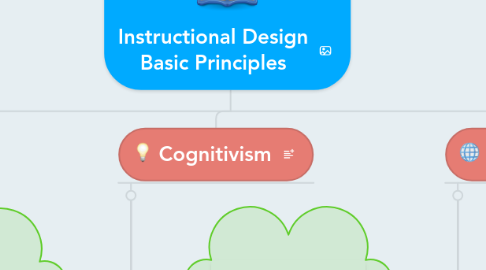
1. Behaviorism
1.1. Embedded Theories
1.1.1. Principal Theorists
1.1.1.1. Bandura
1.1.1.2. Pavlov
1.1.1.3. Skinner
1.1.1.4. Thorndike
1.1.2. Pavlov's Classical Conditioning
1.1.3. Skinner's Operant Conditioning
1.1.4. Stimulus Response Theory
1.1.5. Thorndike's Laws and Connectionism
1.1.6. Information Processing
1.2. Goals of Instruction
1.2.1. Change in behavior
1.2.2. Elicit desired response
1.2.3. Skills of recall and application
1.3. Instructional Models
1.3.1. Computer-based Instruction
1.3.2. Contract Learning
1.3.3. Individualized Instruction
1.3.4. Programmed Instruction
1.3.5. Information Processing Model
1.3.6. Systems Approach
1.4. Implications
1.4.1. Behavioral objectives
1.4.2. Dick & Carey instructional design model
1.4.3. Performance-based assessment
1.4.4. Systems models
1.4.5. Events of Instruction
1.5. Instructional Technologies
1.5.1. Online learning
1.5.2. Tests & quizzes
1.5.3. Guided simulations
1.5.4. Recall activities
1.5.5. Pre/post-assessments
1.6. Wilkinson, J. (2013, February 8). Behaviorism.[Video file]. Retrieved from https://www.youtube.com/watch?v=sRc9Noz80ko
2. Cognitivism
2.1. Embedded Theories
2.1.1. Component Display Theory
2.1.2. Dual Coding Theory
2.1.3. Elaboration Theory
2.1.4. Gestalt Theory
2.1.5. Mental Models
2.1.6. Schema Theory
2.1.7. Subsumption Theory
2.1.8. Principal Theorists
2.1.8.1. Andersont
2.1.8.2. Ausubel
2.1.8.3. Gardner
2.1.8.4. Gagné
2.1.8.5. Merrill
2.1.8.6. Norman
2.1.8.7. Novak
2.1.8.8. Reigeluth
2.1.8.9. Rummelhar
2.2. Goals of Instruction
2.2.1. Knowledge transfer
2.2.2. Create learning or change
2.2.3. Store in memory
2.2.4. Use of prescribed strategy
2.3. Instructional Models
2.3.1. Collins & Stevens Inquiry Teaching Model
2.3.2. Keller's ARCS Model of Motivation
2.3.3. Merrill's Component Display Model
2.4. Implications
2.4.1. Cognitive objectives
2.4.2. Learning strategies
2.4.3. Learning taxonomies (Gagné's intellectual skills)
2.4.4. Prerequisite skills
2.4.5. Task analysis
2.5. Instructional Technologies
2.5.1. Slide/video presentations
2.5.2. Soft skill training
2.5.3. Books/ebooks
2.5.4. Scavenger hunts
2.5.5. Group discussions
2.5.6. Guided simulations/games
2.5.7. Multimedia
2.5.8. Examples & scenario-based tests
2.6. Wilkinson, J. (2013, February 8). Cognitism [Video file]. Retrieved from https://www.youtube.com/watch?v=ibBPqfnhFhU
3. Constructivism
3.1. Embedded Theories
3.1.1. Cognitive Flexibility Theory
3.1.2. Generative Learning Theory
3.1.3. Knowledge as Tools
3.1.4. Situated Cognition
3.1.5. Social-Cultural Learning
3.1.6. Principal Theorists
3.1.6.1. Bransford and the CTGV
3.1.6.2. Bruner
3.1.6.3. Dewey
3.1.6.4. Grabinger
3.1.6.5. Lave & Wenger
3.1.6.6. Papert
3.1.6.7. Piaget
3.1.6.8. Spiro and colleagues
3.1.6.9. Vygotsky
3.2. Goals of Instruction
3.2.1. Learning as constructing knowledge
3.2.2. Engagement
3.2.3. Focus on process not product
3.2.4. Higher order thinking skills
3.3. Instructional Models
3.3.1. Action Learning
3.3.2. Anchored Instruction
3.3.3. Authentic Learning
3.3.4. CaseBased
3.3.5. Learning
3.3.6. Cognitive Apprenticeship
3.3.7. Cognitive Flexibility Hypertext
3.3.8. Collaborative Learning
3.3.9. Communities of Practice
3.3.10. ComputerSupported
3.3.11. Intentional
3.3.12. Learning Environments (CSILEs)
3.3.13. Discovery Learning
3.3.14. Distributed Learning
3.3.15. Epistemic Games
3.3.16. Generative learning
3.3.17. GoalBased
3.3.18. Scenarios (GBSs)
3.3.19. InquiryBased
3.3.20. Learning
3.3.21. Microworlds/Simulations
3.3.22. MOOs and MUDs
3.3.23. ProblemBased
3.3.24. Learning (PBL)
3.3.25. REALs
3.3.26. Reciprocal Teaching
3.3.27. Situated Learning
3.3.28. WebQuest(s)
3.4. Implications
3.4.1. Authentic assessment methods
3.4.2. Learning through exploration
3.4.3. Problem-oriented activities
3.4.4. "Rich" environments
3.4.5. Visual formats and mental models
3.5. Instructional Technologies
3.5.1. Reflection exercises
3.5.2. Puzzles
3.5.3. Video conferencing
3.5.4. Research activities
3.5.5. Collaborative learning
3.5.6. Project-based learning
3.5.7. Problem-solving
3.5.8. Design activities
3.5.9. Creating/building activities
